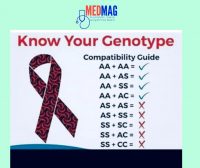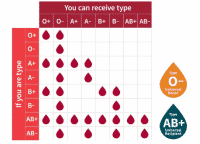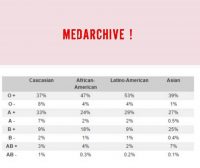Blood type charts are tables or diagrams that contain important details about our blood health. On the other hand, blood donation charts are maps, diagrams, or tables containing vital information about blood donation. It is meant to guide people who want to donate blood so that they can prepare their minds better for the procedure.
We have already discussed the history of blood donation, the origin of the International Association of the Red Cross and Red Crescent, and some other important facts about blood donation like how much blood we can donate at a time, and how often we can donate.
The answers to the above two questions were covered in one post. Please do make out time to read them after going through the charts about blood donation below and saving them to your devices for future use, and reference purposes.
There are lots of information about blood donation which you should know about. But often, we are overloaded with lots of information online that we end up just knowing very little about the important things.
So, I will advise you to screenshot or download the information in the blood donation charts below for reference purposes. Also, do not forget to share them as lots of people need to learn about these facts.
Table of Contents
- Understanding Blood Genotype, Blood Groups, and Rhesus Factor
- 1. Blood Genotype Compatibility Chart for Marriage
- 2. Blood Donation Chart for compatibility
- 3. Paternity Blood Type Chart and Matching
- 4. Rarest Blood Type Chart
- 5. Blood Groups and Associated Diseases
- Conclusion
Understanding Blood Genotype, Blood Groups, and Rhesus Factor
This is by far the most basic of all the details about blood donation. Most often, people do confuse these concepts and may use them interchangeably. But they do not mean the same thing.
From basic human biology, we can find that Genotype is the collection of genes in a person which is inheritable.
The 4 hemoglobin genotypes in humans include:
- AA
- AS
- SS
- AC (very uncommon and not usually seen)
The major importance attached to knowing your hemoglobin genotypes is to guide you in making marriage choices to avoid giving birth to children who may be suffering from sickle cell anemia.
On the other hand, Blood groups are determined by the antibodies and their corresponding antigens which are also found in our blood.
The 4 main Blood Groups Include; Type A, Type B, Type AB, and Type O.
What is the Rhesus Factor?
The Rhesus factor is a marker that shows whether a person has a particular protein on the surface of their red blood cells.
Those people who have these proteins are said to be Rhesus positive (+), and those who do not have the protein are tagged Rhesus negative (-).
The Various Important Blood Type Charts and their Description:
- Blood Genotype Compatibility Chart for Marriage
- Blood Donation Chart for compatibility
- Paternity Blood Type Chart and Matching
- Rarest Blood Type Chart
- Blood Groups and Associated Diseases
1. Blood Genotype Compatibility Chart for Marriage

- Couple 1: AA + AA = All Children will be AA throughout (Excellent Result)
- Couple 2: AA + AS = AA, AA, AS, AS Children (Good Result)
- Couple 3: AA + AC = AA, AA, AA, AC Children (Good Result)
- Couple 4: AA + SS = All Children will be AS throughout (Fair Result)
For all the couples below intending to marry, please speak to a counselor
- Couple 5: AS + AS = AA, AS, AS, SS Children (Very Bad Result)
- Couple 6: AS + SS = AS, SS, SS, SS, SS Children (Very Bad Result)
- Couple 7: AS + AC = AA, AC, AS, SS Children (Very Bad Result)
- Couple 8: SS + SS = SS, SS, SS, SS, SS Children (Very Bad Result)
- Couple 9: AC + SS = AS, AS, SS, SS Children (Very Bad)
- Couple 10: AC + AC = AA, AC, AC, AC, SS Children (Very Bad)
2. Blood Donation Chart for compatibility
The blood donation chart is to help you know who you can donate blood to, and who you can receive blood from.
The table below summarizes it.
| Blood Type | Gives | Receives |
| A+ | A+, AB+ | A+, A–, O+, O– |
| O+ | O+, A+, AB+, B+ | O+, O– |
| B+ | AB+, B+ | B+, B–, O+, O– |
| AB+ | AB+ | Everyone |
| A– | A+, A–, AB+, AB– | A–, O– |
| O– | Everyone | O– |
| B– | B+, B–, AB+, AB– | B–, O– |
| AB– | AB+, AB– | A–, AB–,B–, O– |

3. Paternity Blood Type Chart and Matching
Do you know that apart from DNA testing, you can also use your parent’s blood group and yours to detect if they are your real parents?
This chart is based on the principle of inheritance. But can be wrong in about 1 -10 % of cases. So even if you find out that your blood group does not match with that of your parents using the information in the table below, it is still recommended that you do a DNA paternity test to confirm.
The table below summarized the details about the Paternity blood type chart
| Parent’s Blood Group | Parent 1 | AB | AB | AB | AB | B | A | A | O | 0 | O |
| Parent 2 | AB | B | A | O | B | B | A | B | A | O | |
| Possible Blood Groups for their Children | O | + | + | + | + | + | + | ||||
| A | + | + | + | + | + | + | + | ||||
| B | + | + | + | + | + | + | + | + | |||
| AB | + | + | + | + |
NB: The (+) sign indicates the children that can possibly come from Parent 1 and Parent 2 with the various assigned blood groups. It is accurate for 90-99% of cases.

4. Rarest Blood Type Chart
The rarity of a blood type is very important in blood donation. The reason is that some of these rare blood types engage in what is called autologous blood donation.
An autologous blood donation occurs when a person’s blood is collected and saved up for the future in case the person needs it. This is to help save the person’s life when he/she is sick and in need of blood in the future as it is very difficult to find people with their blood types because it’s rare.
The rarest blood group ever known to man is ‘AB-’. With only about 1.6% of the total world’s population having that blood type.
The image below summarizes the various blood groups based on rarity. You can find out where your own group falls under by calculating the percentage of people who share similar blood groups with you globally.

5. Blood Groups and Associated Diseases
Some persons with various blood groups are known to likely suffer from various diseases during their lifetime.
The table below shows the various diseases and the blood groups that they are associated most with. These facts are based on a study conducted in the United States only.
Various blood types and the diseases they are most likely associated with:
| Diseases | Blood Groups (Rhesus non-specific) |
| Diabetes | A, B, |
| Cognitive Impairment/Learning Disabilities | AB |
| Heart Disease (Coronary Artery Disease) | A, B, or AB |
| Pancreatic Cancer | B, A |
| Stomach Cancer (H. Pylori) | A |
| Plague, cholera, mumps, tuberculosis | O |
| Small Pox, Pseudomonas aeruginosa | A |
| Gonorrhea, Tuberculosis, Streptococcus Pneumonia, Diarrhea, Food poisoning (From E. coli), Typhoid | B |
| Small pox, E. coli, Typhoid | AB |
| Meningitis, Influenza, Candidiasis, Pneumonia, Urinary tract infections (E.coli), cholera, Strep Pyogenes infection. | Non-Secretors |
| Norovirus infection | O |
| Malaria | A B, AB |
| Cancer | A |
| Multiple Endocrine Neoplasia | Mostly O |
| Hypertension | A B |
| Hyperlipidemia (Cholesterol-related Diseases) | A B |
NOTE:
- Non-secretors are groups of persons who do not secrete their blood antigens into their body fluids like saliva, semen, mucus, etc. This is contrary to secretors in whom you can find their various blood type antigens in their body fluids. Find out more about secretors and non-secretors.
- Noroviruses are a group of newly discovered viruses that increases the risk of one having Crohn’s disease, autoimmune gastritis, malabsorption, Vitamin B12 deficiency, and more.
- The information in the table above is based on incident rates and the number of occurrences of the diseases in the people with the associated blood groups. It, therefore, does not imply that if you have any of the above blood groups, that you must suffer from the associated diseases.
Find Blood Donation Centers Near You in Nigeria
Fun Fact!
While adults have about 4.5 – 5 Liters of blood in their body, a new born baby has only about a cup of blood.
Conclusion
There are many information about blood groups, blood donation compatibility, blood types, and some have been summarized in the charts and tables above.
Do well to ask a question using the comment section below if you are confused or need blood clarifications about any of the facts.


